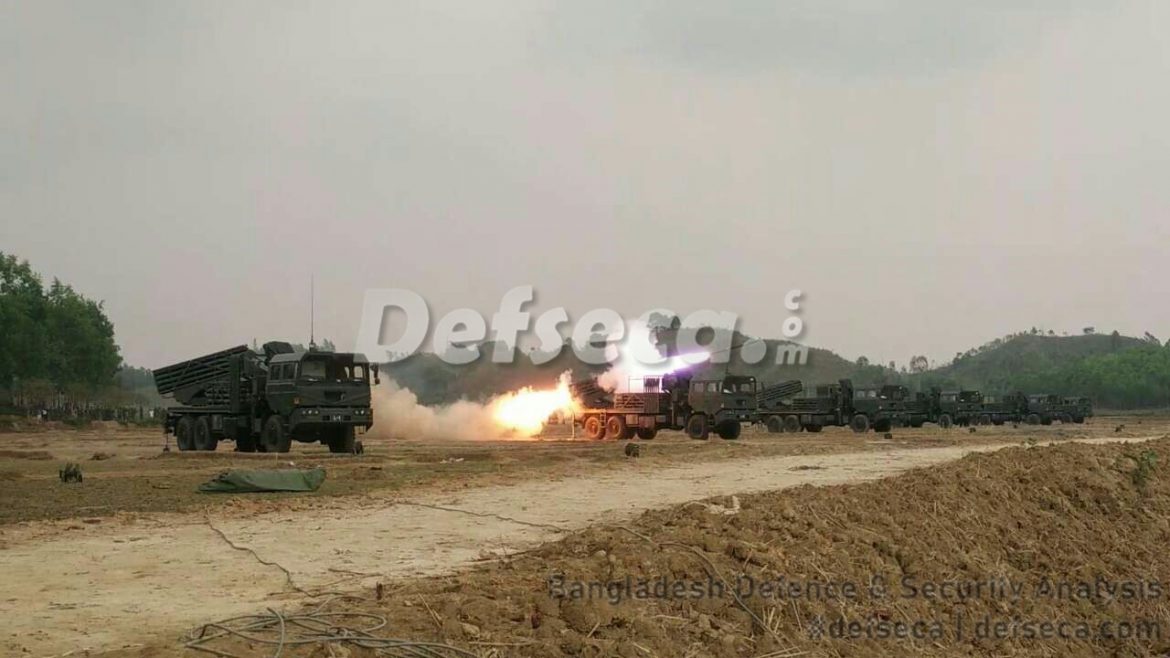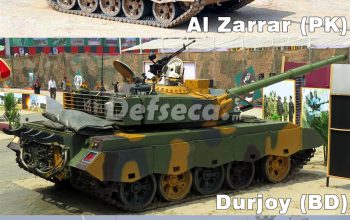Today the Bangladesh Army operates a number of Multiple Launch Rocket Systems obtained from different sources throughout the decades.
The first MLRS was obtained from Pakistan in the form of Khan Research Laboratories’ KRL-122, which is a based on the BM-21 Grad or its Chinese copy, the Type 81. The launching system is mounted on the Reo M35 heavy duty military truck from the US.
The KRL-122 MLRS were supplied with Yarmuk rockets developed by the Pakistan Ordnance Factories (POF), which has a maximum range of over 40 km.
The Bangladesh Army was provided with 7 examples for evaluation purposes. At the end of the evaluation period the Army Headquarters did not deem it suitable for induction because of the large amount of ammunition required to replenish the MLRS.
The launchers obtained from Pakistan were never returned and instead used for training at the Artillery Centre & School of the Bangladesh Army located at Halishahar Cantonment, Chattogram.
The Bangladesh Army continued to use the KRL-122 to this day for training, with rocket munitions imported from China and Pakistan for training purposes.
It was not until early 2000s that the Bangladesh Army re-evaluated its stance on MLRS. The Artillery Directorate at the Army Headquarters decided to incorporate advanced MLRS to strengthen the Army’s fire projection capabilities. And so this plan was approved and integrated in to the Forces Goal 2030 modernisation blueprint of the Bangladesh Army.
MLRS were classified and given designations with Type A, Type B and Type C to form an integral part of the TO&E of the Bangladesh Army. The classifications were based on maximum range of the MLRS, thus Type A had a range of 300 km, Type B had a range of 120 km and Type C had a range of 40 km.
In 2014 the Bangladesh Army took delivery of its first Type C MLRS from China, known as the WS-22. The Bangladeshi variant was mounted on a Taian’an 6×6 heavy duty cross country capable truck. There twin-20 set launchers with another 40 rockets carried onboard for faster self-reloading. The truck was also equipped with a hydraulic crane system and onboard fire control system.
The rockets of the WS-22 were equipped with simple terminal guidance and have a firing range of over 45 km. These rockets were stored in a factory fitted and sealed pods that allows for quicker reloading times and protects the warheads from damage during handling.
A crew of 5 operate the WS-22 in the cab of the heavy duty truck. Moreover unlike other artillery systems of its class the WS-22 is equipped with a retractable canvas cover to help disguise the rocket launcher vehicles as cargo truck.
A battery of WS-22 GMLRS includes a meteorological station, six ammunition carrier trucks, six launcher units and a 4×4 command vehicle. If required the WS-22 launcher unit can be operated independently and remotely.
The Bangladesh Army purchased a total of 5 regiments or 90 launchers with deliveries still continuing during the time of publishing this article.
By 2020 the Bangladesh Army contracted Turkish defence giant ROKETSAN to supply Type B category rockets in the form of ‘Tiger Missile System’. Deliveries for the first regiment began as early as 2021 with over a 180 Bangladesh Army personnel sent to Turkey to receive advance training on the weapons platform ahead of induction.
The Type B or Tiger Missile System has the capability to launch different calibres of rockets from its Multi Calibre Launcher System. The MCL can fire 610 mm, 302 mm and 230 mm rockets/missiles of which the Bangladesh Army reportedly purchased 302 mm and 230 mm rockets/missiles from Turkey, which have a maximum range of 120 km and 70 km, respectively.
The all-weather/day night capable Tiger missile system can be used as a tactical strike weapon system to target artillery and air defence systems of the enemy. It can hit radar sites, factories, assembly areas, logistic facilities, C3 centres and other high priority targets with pin point accuracy of ≤ 10 m CEP. The Tiger Missile System is mounted on Kamaz 6×6 chassis and can obtain targeting information from unmanned aerial vehicles, which are incorporated in to the Bangladesh Army’s inventory.
In the near future the Bangladesh Army will induct the Type A GMLRS, which have a maximum range of 300 km due to MTCR regulations. The Army may opt to extend the range of the rocket/missile systems to nearly 1,000 km to attain solid SRBM ranges.
Countries such as China, Turkey, Ukraine and Belarus have offered their respective long range GMLRS systems to the Bangladesh Army for induction. We have witness a decision on the purchase of the Type A category GMLRS shortly given the official RFI was disclosed two years earlier.
In conclusion it is clear the Bangladesh Army realised the importance of maintaining an overwhelming firepower edge over its adversaries on the battlefield at all echelons. This realisation bodes well for the operational effectiveness of the Army as a force, which is witnessing a golden period of growth in recent years.




